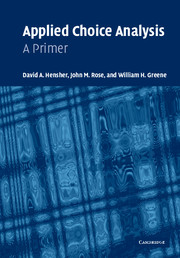14 - Nested logit estimation
Published online by Cambridge University Press: 05 September 2012
Summary
In mathematics you don't understand things. You just get used to them.
(Johann von Neumann, 1903–57)Introduction
The majority of choice study applications do not progress beyond using the simple MNL model discussed in chapter 10. The ease of computation and the wide availability of software packages capable of estimating the MNL model suggest that this trend will continue well into the future. The ease with which the MNL model may be estimated, however, comes at a price in the form of the assumption of Independence of Identically Distributed (IID) error components. While the IID assumption and the behaviorally comparable assumption of Independence of Irrelevant Alternatives (IIA) allow for ease of computation (as well as providing a closed-form solution), as with any assumption, violations both can and do occur. When violations do occur, the cross-substitution effects observed between pairs of alternatives are no longer equal given the presence or absence of other alternatives within the complete list of available alternatives within the model (Louviere, Hensher, and Swait 2000).
The nested logit (NL) model represents a partial relaxation of the IID and IIA assumptions of the MNL model. As discussed in chapter 13, this relaxation occurs in the variance components of the model together with some correlation within sub-sets of alternatives, and while more advanced models relax the IID assumption more fully (via the covariances), the NL model represents an excellent advance for the analyst in terms of studies of choice.
- Type
- Chapter
- Information
- Applied Choice AnalysisA Primer, pp. 518 - 604Publisher: Cambridge University PressPrint publication year: 2005



